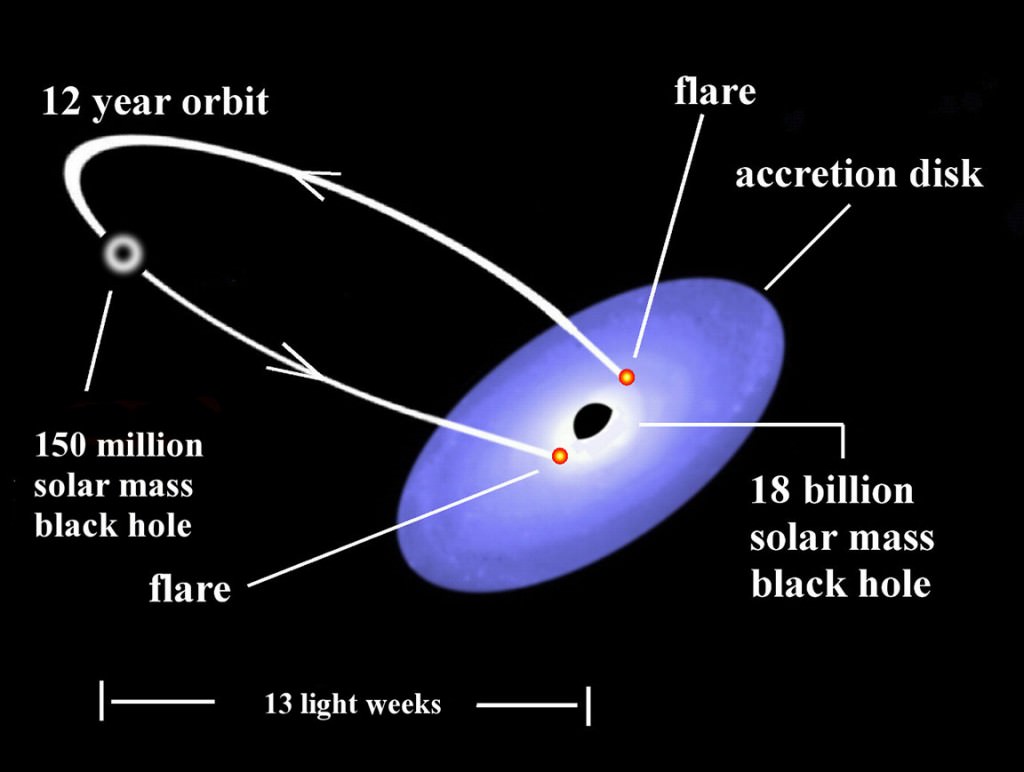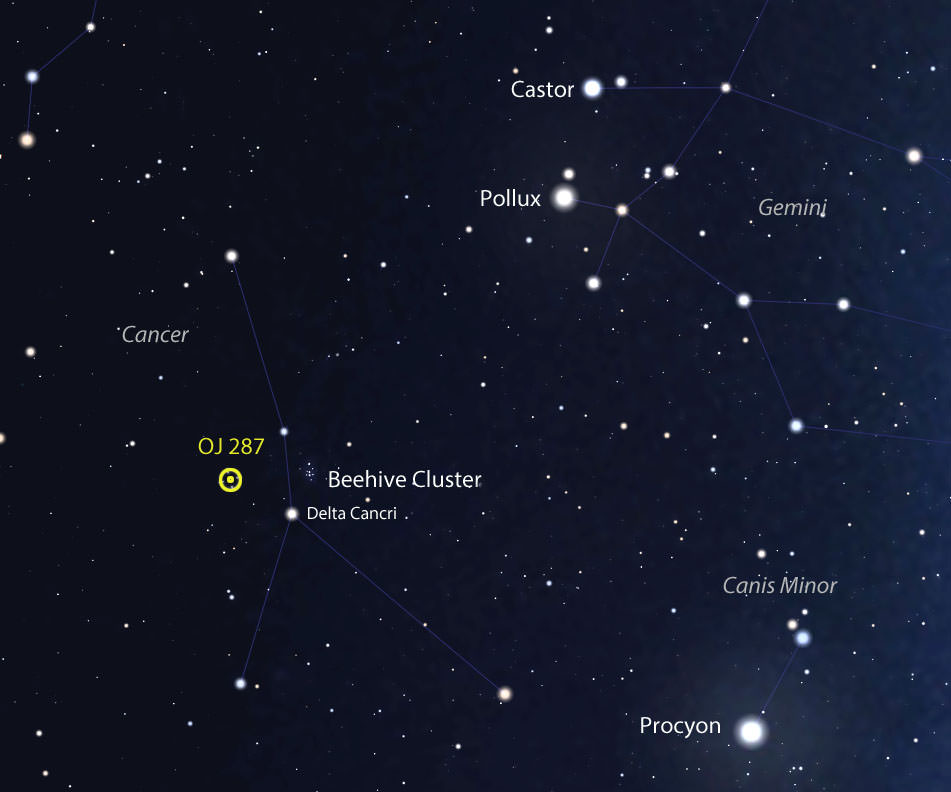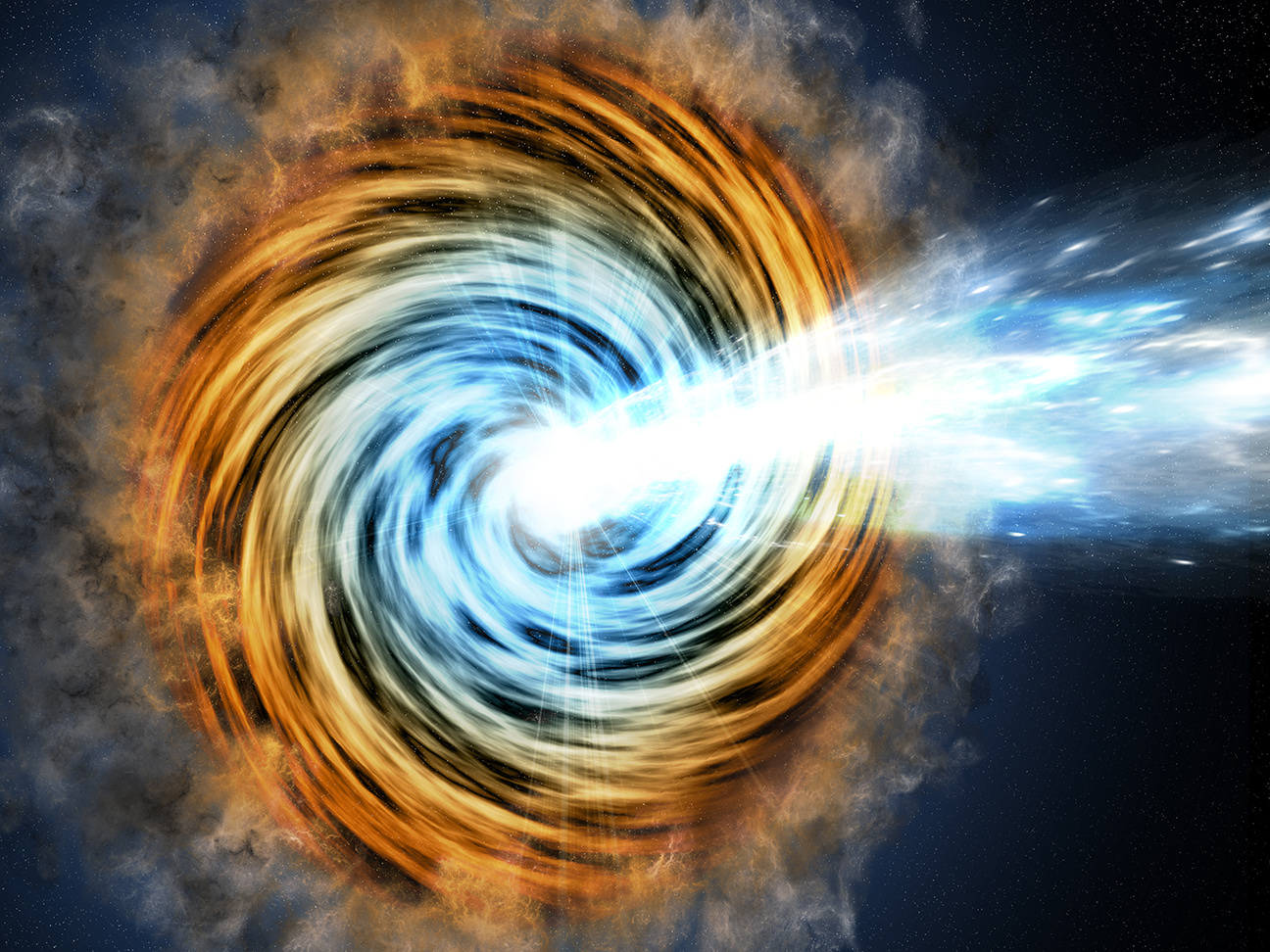Way up in the constellation Cancer there’s a 14th magnitude speck of light you can claim in a 10-inch or larger telescope. If you saw it, you might sniff at something so insignificant, yet it represents the final farewell of chewed up stars as their remains whirl down the throat of an 18 billion solar mass black hole, one of the most massive known in the universe.

Credits: M. Weiss/CfA
Astronomers know the object as OJ 287, a quasar that lies 3.5 billion light years from Earth. Quasars or quasi-stellar objects light up the centers of many remote galaxies. If we could pull up for a closer look, we’d see a brilliant, flattened accretion disk composed of heated star-stuff spinning about the central black hole at extreme speeds.

As matter gets sucked down the hole, jets of hot plasma and energetic light shoot out perpendicular to the disk. And if we’re so privileged that one of those jet happens to point directly at us, we call the quasar a “blazar”. Variability of the light streaming from the heart of a blazar is so constant, the object practically flickers.

A recent observational campaign involving more than two dozen optical telescopes and NASA’s space based SWIFT X-ray telescope allowed a team of astronomers to measure very accurately the rotational rate the black hole powering OJ 287 at one third the maximum spin rate — about 56,000 miles per second (90,000 kps) — allowed in General Relativity A careful analysis of these observations show that OJ 287 has produced close-to-periodic optical outbursts at intervals of approximately 12 years dating back to around 1891. A close inspection of newer data sets reveals the presence of double-peaks in these outbursts.

To explain the blazar’s behavior, Prof. Mauri Valtonen of the University of Turku (Finland) and colleagues developed a model that beautifully explains the data if the quasar OJ 287 harbors not one buy two unequal mass black holes — an 18 billion mass one orbited by a smaller black hole.
OJ 287 is visible due to the streaming of matter present in the accretion disk onto the largest black hole. The smaller black hole passes through the larger’s the accretion disk during its orbit, causing the disk material to briefly heat up to very high temperatures. This heated material flows out from both sides of the accretion disk and radiates strongly for weeks, causing the double peak in brightness.
The orbit of the smaller black hole also precesses similar to how Mercury’s orbit precesses. This changes when and where the smaller black hole passes through the accretion disk. After carefully observing eight outbursts of the black hole, the team was able to determine not only the black holes’ masses but also the precession rate of the orbit. Based on Valtonen’s model, the team predicted a flare in late November 2015, and it happened right on schedule.

The timing of this bright outburst allowed Valtonen and his co-workers to directly measure the rotation rate of the more massive black hole to be nearly 1/3 the speed of light. I’ve checked around and as far as I can tell, this would make it the fastest spinning object we know of in the universe. Getting dizzy yet?


“…jets of hot plasma and visible light ” are exiting this massive body. One word can describe this phenomenon…..Plasmoid. This structure is so clearly an electromagnetic phenomenon it boggles the mind that anyone can think gravity has anything to do with it. These structures can be very simply explained using the basic laws of electrical engineering and plasma physics. Unfortunately today’s cosmologists have their heads stuck in the sand and refuse to recognize or acknowledge this fact. For those that want to understand a simple model of these structures (“black hole” is a misnomer….they are not holes in anything and they are not black either), I will refer to multiple presentations by both Donald Scott and Wal Thornhill.
A post about black holes and, yup, right on queue. Here’s btraymd to squeeze out yet more incoherent Electric Universe spam in the comments section of an article he hasn’t read and couldn’t understand if he did.
Wow, direct verification of the three things you hate most: black holes, general relativity, and accretion discs- in one beautiful observation! How galling for you that the evidence in favour of science just keeps piling up, and up, and up. I mean, I know you’ve been in panic mode since the LIGO detection of gravitational waves, and here’s more direct observational evidence for the knockout punch. Science moved on from plasma cosmology decades ago when the evidence didn’t support it. Didn’t you get the memo? You’ve gone the way of the Flat Earthers and the phlogiston enthusiasts.
If mainstream cosmologists are wrong about the existence of black holes, and wrong about general relativity, and if accretion discs don’t exist- as you claim- how come these researchers were able to correctly forecast the November 2015 outburst?
And if you Electric Universe nutjobs are right about everything being a manifestation of electric forces, how come you didn’t predict this? Come to think of it, if you’re right, how come you can’t predict or explain anything at all?
I’m no astronomer, but here is what you missed:
1) The ring provide your plasmoids
2) The black hole provides the gravitational energy to the ring
3) The black hole does not radiate energy at any wave length (thus its black), except theorised secondary radiation called Hawking Radiation.
to translate black hole to you:
black stands for “does not emit radiation at anywave length”
hole stands for “things go in, but don’t come out”.
– The gravity is to strong for matter or light to leave a black hole.
conclusion:
no black hole results in no energy in the rings to provide your plasmoids …
You really need to apply for the job of “Guy That Knows More Than Thousands upon Thousands of learned professionals who are obviously making all this stuff up because they’re dirty rotten liars”. How good does it make you feel to bang your head against walls of people that think (know) you’re nuts with information not a one of them even begins to lend credibility to? You must really have a low self esteem to need to prop it up like this………………….. What, do think that some day people will suddenly go, “Hey, BTRAYMD is obviously right and we’re all wrong”. Then ask you to be the king of all astrophysicists and you’ll then live in a big castle and everyone will worship you? You’re wrong… Period… To think that astrophysics is one big sham as you obviously do is to be delusional at best. (I say imagining that one day BTRAYMD will suddenly go, “Wow, I’ve been wrong all along and Jeffrey Boerst is now my idolized leader whom I shall follow to the end of my days”…) lol
WOW! 18 billion solar masses… awesome! It’s hard enough to visualize one solar mass much less 18 billion! What would a dark energy map of the region look like? An early target for the JWST?
Consider this? It would take 1.3 million Earths to fill up the Sun. That’s a lot of Earths. Now multiply 1.3 million times 18 billion = a mass equal to 23.4 quadrillion earth’s!
Then, via gravity, squeeze those 23.4 quadrillion Earths down to a singularity…..
Let’s just look at the facts that we can document and compare them to the unproven mathematical conjecture that has never been observed:
Facts:
1. Massive magnetic fields have been measured surrounding “black holes”.
2. Visible light is now documented to emanate from “black holes”.
3. Massive plasma jets are now documented to exit these structures.
4. Massive amounts of electromagnetic radiation (mainly gamma and xray) emanate from these bodies.
Unproven Concepts:
1. The singularity. This requires the known laws of physics to be abandoned in favor of ….?? Mathematics??
2. Gravitational forces the power of which however has never been measured or observed. They must arise from mass, the density of which has never been observed and also requires the known laws of physics to again be abandoned.
3. Dark Matter. Proposed by mathematical theorists to account for the fact that gravity has insufficent force to account for galactic structure. This concept has never been experimentally confirmed or observed.
4. “Black Holes”. There is no evidence that there is a hole in anything. There is now contradictory evidence that visible light emanates from these bodies and they are therefore not “black”. I would suggest the term “galactic nucleus” in lieu of the ridiculous term “black hole”. The only black hole I can think of is the amount of understanding demonstrated by the current cosmological models.
No one wants to address the source of the massive magnetic fields. Using well known scientific principles it must be concluded that there is a massive electric current within these structures.
A model which excludes unproven conjecture and accounts for the known facts can be proposed using the sound scientific principles of electrical engineering and plasma physics. This theory proposes that these galactic nuclei are super dense, rapidly rotating plasmoids. There is experimental evidence for this model. Anthony Peratt demonstrated galaxy formation using only electric current, magnetic fields and plasma. His models showed velocities that were adequate to maintain galactic structure with the need for black holes or dark matter. His work has been reproduced by numerous plasma physics labs.
It would behoove cosmologists to remember Occam’s Razor when considering which of the 2 models may better reflect reality.
Dear readers, please observe the extreme charlatanism of btraymd’s post.
First of all, the jets and electromagnetic radiation do not emanate from the black hole itself, but from the accretion disc of inspiralling matter around it. Btraymd understands the distinction- this is the fifth time I’ve explained it to him- but he’s hoping the reader won’t.
His diatribe then segues into an attack on scientists allegedly replacing physics with mathematics. This is bizarre and irrelevant. All physical laws are mathematical in form, even the laws of electromagnetism that are so precious to him. He also calls black holes “unproven”- this is just a bit of desperate dogma he keeps repeating over and over. In fact, there are now so many multiple lines of evidence in favour of the existence of black holes that their reality cannot seriously be disputed.
The LIGO detection of gravitational waves matches perfectly the general relativistic prediction of two inspiralling black holes- the EU framework predicts that this detection should not have happened at all. This article details the correct prediction orbit of a precessing second black hole around an 18 billion solar mass behemoth black hole well enough to correctly forecast an outburst. Where is the EU nutters’ prediction or explanation of this event? There’s many, many other lines of evidence.
He then goes on to attack dark matter, again falsely claiming there is no direct evidence for it. Wrong again. We can directly infer its existence from gravitational lensing- another phenomenon the EU people predict shouldn’t exist. His problem with dark matter is that there isn’t enough regular matter we see and he objects to inferring a source of mass that does not emit light. He prefers to explain it with magnetic fields that we can detect, but which astronomers can see are orders of magnitude too weak to perform all the miracles he demands of them.
The other bit of dishonesty I’d like to draw your attention too is how btraymd moves from discussing galactic *nuclei* to experiments allegedly about *entire galaxies*. This is a sleight of hand I’m sure he was hoping nobody would notice. We weren’t supposed to notice that simulations about the formation of entire galaxies don’t explain alleged plasmoids at their cores. In any case, the reason scientists moved on from plasma cosmology explanations for galaxy formations is that these require a source of huge electric currents all over the place, and there is just no credible origin for such currents. There just isn’t any place these giant invisible dynamos in the sky could be lurking, or we’d have noticed.
AMEN, brother!!! *as MEWO drops the mic*
I think there is some confused terminology – maybe in the article as well.
The article says that the rotational rate is 1/3 the speed of light. I’m not sure that is a reasonable statement.
I tend to consider a black hole to be a volume bounded by the event horizon roughly centered on a massive singularity.
I consider the accretion disk to be a separate entity although it is obviously profoundly gravitationally associated with the black hole.
I suspect the article would be more correct if it specified that as we measure it the speed of at least a portion the accretion disk is about 1/3 the speed of light.
Wow, I used Wolfram alpha to calculate the event horizon and it’s 35.5 AU
I got 355 AU. Did you put in 18 billion solar masses, or 1.8 billion?
Such a big black hole raises some questions in my mind that I know someone here can help me to understand.
Is this a stellar remnant? Or is it more like the SMBHs in the heart of galaxies? Since it was described as a Quasar, my guess is that it is at the heart of a galaxy???
Any help is appreciated (Please no Electric universe stuff).
Eighteen billion solar masses is definitely way too big to be a stellar remnant. This is almost certainly a central SMBH. Of course, this isn’t to say the SMBG hasn’t absorbed smaller, stellar remnant, black holes over its lifetime.
I would also guess that the second black hole, orbiting the big one, was once at the core of another galaxy and that they’ve ended up together as a result of a galactic merger.
Thank you MEWO.
You also answered my next question before I could ask it! I also suspected that the orbiting BH was the core of a cannibalized dwarf galaxy.